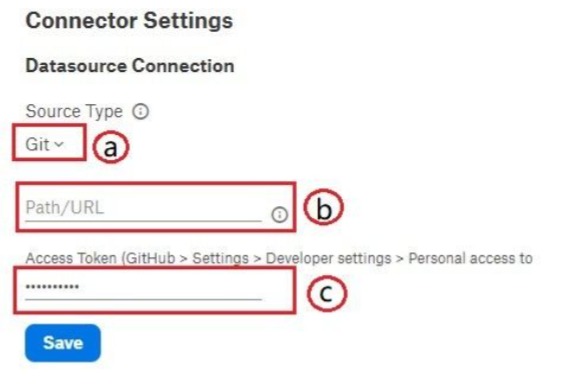Configure the Data Source Connection¶
Alation Cloud Service Applies to Alation Cloud Service instances of Alation
Customer Managed Applies to customer-managed instances of Alation
After you install the Talend OCF connector, you must configure the connection to the Talend data source.
The various steps involved in configuring the Talend data source connection setting are:
Provide Access¶
To set the data source visibility,go to the Access tab on the Settings page of your Talend data source, set the data source visibility using these options:
Public Data Source — The data source is visible to all users of the catalog.
Private Data Source — The data source is visible to the users allowed access to the data source by Data Source Admins.
You can add new Data Source Admin users in the Data Source Admins section.
Connect to Data Source¶
To establish the a connection to data source, you must:
Configure Authentication¶
For metadata extraction (MDE), the connector supports GitHub Personal Access Token authentication.
Configure Access Token Authentication¶
On the Settings page of your Talend data source, go to the General Settings tab.
In the Connector Settings section, provide the following details in the Datasource Connection section.
Field
Description
Source Type
Select Git from the source type.
Path/URL
Specify the GitHub path based on the type of authentication you want to use.
Access Token
Specify the GitHub Personal Access Token

Test the Connection¶
The connection test checks database connectivity.
After configuring authentication, test the connection.
To validate the network connectivity, go to General Settings > Test Connection of the Settings page of your Talend data source and click Test.
A dialog box appears confirming the status of the connection test.
Configure Additional Connection Settings¶
Apart from the mandatory configurations that you perform to connect to the data source on the General Settings tab, configure the following additional settings:
Configure Additional Datasource Connection¶
Alation can associate objects in a data source with objects in another source in the catalog through lineage. For example, you can show lineage between your data source and BI sources that use its data.
Provide additional connection information for the data source to see lineage across multiple sources on the Lineage chart.
Follow these steps:
On the Settings page of your Talend data source, go to the General Settings tab.
In the Application Settings section, provide the following details:
Field
Description
Connection URL
Provide one or more comma separated values in the format: <host1>:<port1>,<host2>:<port2>
For example: 10.13.71.216:1541,sever.com:154
Save the settings.
Disable Automatic Lineage Generation¶
You can enable or disable the lineage for the data source to be generated automatically during metadata extraction (MDE).
On the Settings page of your Talend OCF data source, go to General Settings > Application Settings.
Toggle Disable automatic lineage generation to disable and automatically generate the lineage.
Enable this option when you don’t want lineage to be automatically generated and prefer to create lineage manually or using an API.
By default, automatic lineage generation is enabled.
Configure Logging¶
To set the logging level for your Talend OCF data source logs, perform these steps:
On the Settings page of your Talend OCF data source, go to General Settings > Logging configuration.
Select a logging level for the connector logs and Save the settings.
The available log levels are based on the Log4j framework.
You can view the connector logs in Admin Settings > Server Admin > Manage Connectors > Talend OCF connector.
